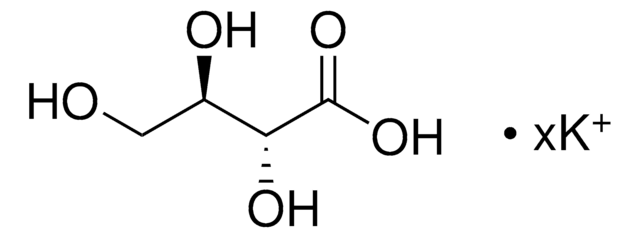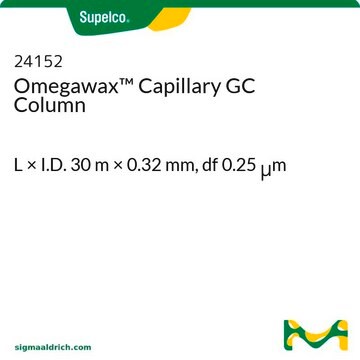24056
Colonne capillaire pour la GC SP®-2560
L × I.D. 100 m × 0.25 mm, df 0.20 μm
Synonyme(s) :
SP-2560, 100 M 0,20 UM 0,25 MM
About This Item
Produits recommandés
Matériaux
fused silica
Agence
AOAC® 2012.13,Ce 1-h05,996.06
meets requirements for USP G5
Paramètres
≤25-250 °C temperature (isothermal or programmed)
Valeur bêta
313
df
0.20 μm
Technique(s)
gas chromatography (GC): suitable
L × D.I.
100 m × 0.25 mm
Groupe de la matrice active
Non-bonded; poly(biscyanopropyl siloxane) phase
Application(s)
agriculture
clinical
food and beverages
Type de colonne
capillary highly polar
Vous recherchez des produits similaires ? Visite Guide de comparaison des produits
Catégories apparentées
Description générale
Code USP : Cette colonne répond aux exigences de l'USP G5.
Phase :
- Non greffée
- Poly(biscyanopropylsiloxane)
- De sub-ambiante à 250 °C (isotherme ou programmée)
Autres remarques
Informations légales
Application
Choose from one of the most recent versions:
Déjà en possession de ce produit ?
Retrouvez la documentation relative aux produits que vous avez récemment achetés dans la Bibliothèque de documents.
Les clients ont également consulté
Protocoles
A protocol for GC Analysis of a 37-Component FAME Mix on SP™-2560.
GC Analysis of a 37-Component FAME Mix on SP™-2560, Slower Oven Ramp
FAME Standard for Optimizing GC System Performance
Fast GC Analysis of Detailed cis/trans Fatty Acid Methyl Esters (FAMEs) on the 75 m SP™-2560 Capillary Column
Chromatograms
suitable for GCsuitable for GCsuitable for GC, application for SPEsuitable for GCNotre équipe de scientifiques dispose d'une expérience dans tous les secteurs de la recherche, notamment en sciences de la vie, science des matériaux, synthèse chimique, chromatographie, analyse et dans de nombreux autres domaines..
Contacter notre Service technique






